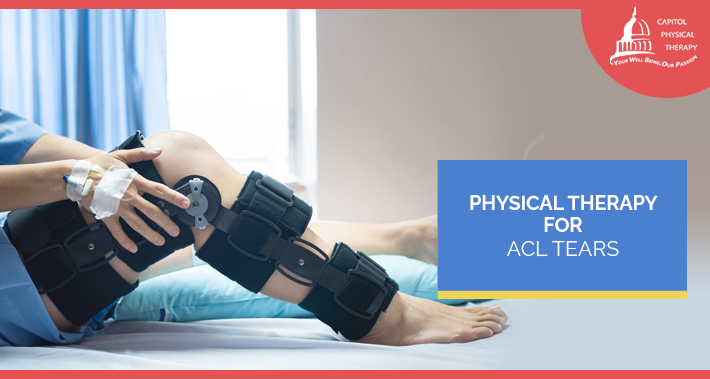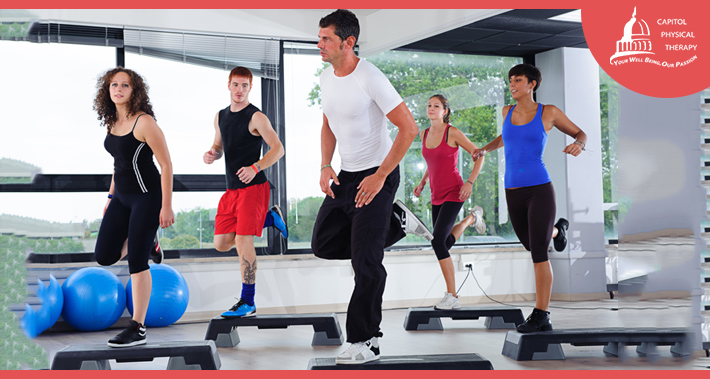
Have you experienced a knee injury that resulted in an ACL tear?
An ACL tear is a common injury that affects both athletes and non athletes.
In the United States alone there are about 200,000 annual diagnosed ACL injuries.
ACL tears can occur in sports from direct contact and non contact injuries.
Injuries can happen from awkward movements, sharp turns, or hard impacts from jumping and landing.
Working with both a physical therapist and surgeon can help you decide the best way to recover and how to modify your physical activity to aid in your healing.
Sports medicine physical therapy is a great resource for injury management, and injury prevention and improvement.
At Capitol Physical Therapy we can also help you by providing physical therapy for post surgery recovery if that’s your best route.
So let’s take a closer look at what ACL tears are and how physical therapy can benefit you.
What Is An ACL Tear?
ACL stands for anterior cruciate ligament.
The ACL is a strong tissue band that connects your thigh bone (femur) to your shinbone (tibia) at the knee joint.
An ACL tear is a common sports injury that can occur when you put pressure on the knee joint through:
- Sudden stops and changes in direction
- Jumping and landing
- Hitting the knee directly
- Stretching your knee past its range of motion
- Suddenly shifting your weight between legs
RELATED: What Happens When You Pull A Muscle?
What Does An ACL Injury Feel Like?
Many times when an ACL injury occurs, people hear a pop or feel a “popping” sensation in their knee.
You may feel very sharp, intense pain in your knee following an ACL tear.
Your knee might also become swollen.
The injury may make you unstable and not allow you to support any weight on the affected joint when you walk.
You are also likely to lose your range of motion.
If you have any of the signs and symptoms of an ACL tear, it’s a good idea to seek immediate care.
How Is An ACL Tear Diagnosed?
Consulting a physical therapist will help you evaluate the severity of your injury and begin proper treatment.
Your physical therapist will go over the signs and symptoms associated with an ACL tear.
They might also perform gentle “hands on” tests to determine if you have an ACL tear or another type of knee injury, like patellofemoral pain.
If you go to an orthopedic surgeon for diagnosis they may perform further tests, such as an MRI.
How Can Physical Therapy Help With ACL Tears?
Physical therapy services can help you with ACL injuries through injury management as well as injury prevention and physical improvement.
Once diagnosed with an ACL tear, together with your physical therapist and surgeon, you will decide if you need surgery.
If you don’t need surgery, your physical therapist will help you regain your muscle strength, balance, and flexibility.
Other treatments may include electrical stimulation to your quadriceps to further reduce pressure to the knee.
Physical therapy may require you to modify your physical activity to reduce stress on your knee to help recovery.
With physical therapy, we want to get you back to living your life as soon as possible.
Preparing For Surgery
It can be scary to find out that you need surgery.
At Capitol Physical Therapy we’re here to help with your recovery.
If you need surgery, your physical therapist can help you with some short course rehabilitation prior to having surgery.
This can improve your range of motion, strengthen the muscles around your knee, and reduce swelling.
Following your surgery, your orthopedic surgeon and physical therapist will work together to create a treatment program.
Weight Bearing Exercises
You will generally go home the same day after having surgery on your ACL.
Your doctor will likely fit you for a splint or knee brace to help support your knee.
You will have to use crutches to walk for a certain period of time to avoid putting too much weight on your leg.
The length of time that you will need to use crutches depends on the type of surgery you have and the extent of the damage.
About two to three weeks after your surgery you will be able to put weight on your knee again.
Physical therapy can help slowly guide you toward being able to bear your full weight after your injury.
Ice, Compression, and Bracing
After your surgery you will have to control the swelling in your knee.
A good method to keep in mind is “RICE”, or rest, ice, compression, and elevation.
Your physical therapist will also recommend controlling your swelling with a cold application, such as an ice sleeve.
You may also receive a brace to limit your knee’s mobility as you recover.
However, keep in mind that wearing a knee brace doesn’t fully prevent an ACL injury or reduce the risk of it happening again.
But it’s still a good idea to limit the movement in your knee until it is recovered enough to go back to your daily activities.
RELATED: Understanding Heat And Cold Therapy

Exercises to Rebuild Movement
The first step on your road to recovery is to slowly get your knee moving again.
Following surgery you will start by doing gentle exercises at home provided by your physical therapist.
These early movement exercises focus on helping you increase blood flow in your knee, which also helps reduce swelling.
Strengthening Exercises
Once you regain movement in your knee and increase your ability to put weight on it, it’s time to add strengthening exercises.
Exercises will focus on building strength in your thigh muscles (the quadriceps and hamstrings) for overall balance in leg strength.
You might be limited to a specific range of motion to protect your ACL.
On top of strengthening your thigh muscles, it’s also important to target your core, such as your hips, pelvic floor, and lower abdomen.
This helps with your posture to avoid moving the knee inward during exercise.
As the weeks go by your physical therapist will gradually increase the intensity of your exercises.
Balance Exercises
Physical therapy balance exercises will help you rebuild your ability to stay upright, and to shift your weight on your surgery leg.
The progression of these activities will eventually lead you to standing on your surgery leg on firm and unsteady surfaces.
The road to recovery is gradual and you should expect physical therapy after ACL surgery to last between two to six months.
Exercises To Return You To Your Sport
The end goal is to re-establish your strength and get you back to your athletic activities.
As your strength and balance come back it’s advisable to focus your training on proper technique and knee position.
Emphasis should be given on technique when pivoting making and cutting movements.
At this stage athletes can begin running, jumping, hopping, and other exercises that are specific to their sport.
Can An ACL Tear Heal Without Surgery?
When the ACL is damaged there may be either a partial or complete tear.
A mild injury may stretch your ACL but leave it intact.
Research found a specific set of patients who can potentially heal from an ACL tear without surgery.
This affects you if you injured only the ACL and have not had episodes of your knee “giving out” after the injury.
Treatment depends on the severity of your ACL injury and may include rest and rehabilitation exercises.
Other potential treatments may include balance training, developing muscle strength, and electrical stimulation to restore thigh muscle strength.
Book Your Appointment With Capitol Physical Therapy Today
If you’ve experienced an ACL tear, we can help.
Capitol Physical Therapy’s approach is through the prevention, evaluation, and treatment of sports injuries.
We’ll help you find the right type of physical therapy you need based on your sport and how to get you back to living your life.
Book your appointment with Capitol Physical Therapy today.
1331 H St NW #200,
Washington, DC 20005
- https://g.page/capitolptdc
9560 Pennsylvania Ave. # 202,
Upper Marlboro, MD 20772
- https://goo.gl/maps/zjL4NnnuThRhrcS86
Capitol Physical Therapy offers orthopedic and other pain related solutions, with our versitile team of physical therapists in Washington, DC